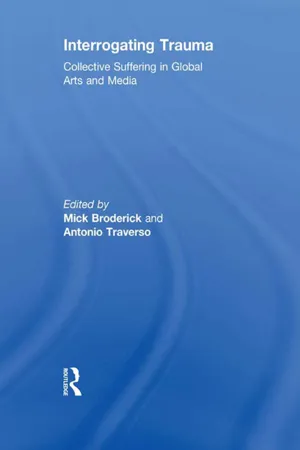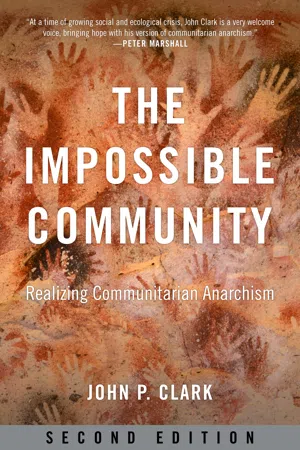Hurricane Katrina
Hurricane Katrina was a powerful and destructive Category 5 hurricane that struck the Gulf Coast of the United States in August 2005. The storm caused widespread devastation, particularly in the city of New Orleans, due to flooding from breached levees. The event highlighted the vulnerability of coastal areas to extreme weather events and the importance of effective disaster preparedness and response.
4 Key excerpts on "Hurricane Katrina"
- eBook - ePub
Interrogating Trauma
Collective Suffering in Global Arts and Media
- Mick Broderick, Antonio Traverso, Mick Broderick, Antonio Traverso(Authors)
- 2013(Publication Date)
- Routledge(Publisher)
...Hurricane Katrina had formed over the Bahamas during the third week of August 2005, and went on to make its second landfall as a Category 3 hurricane southeast of New Orleans during the early morning hours of Monday 29 August 2005. US President George W. Bush had declared a state of emergency in selected regions two days prior, and Louisiana Governor Kathleen Blanco and New Orleans Mayor Ray Nagin had ordered mandatory evacuations that were undertaken by more than 1 million people. For those without the ability or means to evacuate, state and local authorities had designated various ‘shelters of last resort’, including the capacious Louisiana Superdome. In the hours following landfall, the storm surge swelled Lake Pontchartrain and the Intercoastal Waterway, overtopping the levees and breaching the floodwalls in various locations in and around the city. In the days that followed, responders in helicopters, boats, and buses finally arrived to rescue and transport out of the area the tens of thousands of people stranded at the Superdome, at the Ernest N. Morial Convention Center, on the Interstate 10 freeway, and elsewhere. At least 1836 people lost their lives in what is generally regarded as the greatest natural disaster in US history, although it has been critiqued from a social ecological perspective as eminently ‘unnatural’. Investigations ensued, both of the failure of the flood control system on the Gulf Coast, a system that had been deemed grossly inadequate prior to the storm, and of the federal, state, and local preparation and response...
- eBook - ePub
Crisis and Disaster Counseling
Lessons Learned From Hurricane Katrina and Other Disasters
- Priscilla Dass-Brailsford(Author)
- 2009(Publication Date)
- SAGE Publications, Inc(Publisher)
...history, resulting in more than 1,600 deaths and displacing hundreds of thousands of people (Louisiana Department of Health and Hospitals, 2006). African Americans and the socioeconomically distressed people living in areas that were supposedly protected by the failed levee system were particularly hard hit by the disaster. New Orleans lost almost half its population to other parts of the country, where many survivors of the storm were initially evacuated. For years, Category 4 or 5 storms had threatened the Gulf Coast. Predictions were made that the bowl New Orleans occupies would become completely awash with water and chemical products, making it a massive tomb and potentially killing tens of thousands of people. The disaster of Hurricane Katrina took Americans by surprise; yet in many ways, it was not a surprise at all. It almost appeared straight from the textbooks in terms of its impact and effect on vulnerable groups. Besides dispossessing many communities, Hurricane Katrina exposed bureaucratic mismanagement as well. The hurricane wreaked chaos up and down the Gulf Coast and deep into the interior. It affected several states in its path, but its destructive impact on New Orleans was of epic proportions. There are multiple reasons for this: the city’s people suffered grievously, its physical damage was enormous, and the storm’s ability to dislocate hundreds of thousands of people was unparalleled, injecting misery not only into New Orleans but also into the country as a whole. New Orleans has always held a special place in American culture that made its ordeal especially significant. There have been several analyses of the storm and what went wrong. All of the explanations appear to be plausible, but the question of whether the consequences of the storm were preventable still remains...
- eBook - ePub
Emergency Management
The American Experience
- Claire B. Rubin, Claire B. Rubin(Authors)
- 2019(Publication Date)
- Routledge(Publisher)
...Chapter 7 2005 Events and Outcomes: Hurricane Katrina and Beyond Melanie Gall and Susan L. Cutter The year 2005 was a record year for the socioeconomic impact of disasters in the United States. This chapter revisits the catastrophes that occurred during 2015 (Hurricane Dennis, Hurricane Katrina, Hurricane Rita, and Hurricane Wilma) and reviews some of the lessons learned since then regarding effective mitigation, sustainable recovery, and vulnerability awareness. It also highlights some of the weaknesses of the existing mitigation and recovery strategies, including the diminished local preparedness, response, and recovery capacities in a post-9/11 environment. This review shows that the 2005 hurricane season did not trigger the same type of sweeping organizational changes as were seen post-9/11 even though it should have been a wake-up call for governments at all levels to adjust the U.S. emergency management system-to move toward a real emphasis on long-term loss reduction from all possible hazards. Major challenges remain with regard to areas like medical preparedness, information sharing, private sector preparedness, and community recovery as subsequent disasters (e.g., Hurricane Sandy, Hurricane Maria) continue to reveal. A commitment to hazard mitigation, such as increases in financial allocation and a shift to pre-disaster investments and pre-event recovery planning-two key factors that contributed to the losses from Hurricane Katrina-remain elusive. T he year 2005 was a record year for hazards and disasters in the United States. Most of the losses were associated with Hurricane Katrina, which caused damage in excess of $100 billion 1 and led to more than 1,800 deaths...
- eBook - ePub
The Impossible Community
Realizing Communitarian Anarchism
- John P. Clark(Author)
- 2022(Publication Date)
- PM Press(Publisher)
...8 Disaster Anarchism: Hurricane Katrina and the Shock of Recognition The following reflections on the Hurricane Katrina disaster and its aftermath consider the contradictory, radically divergent dimensions of crisis and traumatic experience. The first section is based (with only minor changes) on a text written for an international conference in Milan on Elisée Reclus, the foremost geographer of his time and a major communitarian anarchist political theorist. I was scheduled do a presentation at the conference, but six weeks before it took place, the Hurricane Katrina disaster hit. I was still too heavily involved in the recovery to attend the conference, so I quickly composed this text and sent it as my contribution. It was written very much in the midst of crisis, as was the second section, a postscript written nine months later, on the first day of the next hurricane season. The central theme of these reflections is that although the Katrina disaster offers abundant evidence of how crisis creates ideal opportunities for intensified economic exploitation, what has since then come to be called “disaster capitalism,” 1 and also for increased repression, brutality, and ethnic cleansing, which might be called “disaster fascism,” it also creates the conditions for an extraordinary flourishing of mutual aid, solidarity, and communal cooperation, something we might call “disaster anarchism.” Reclusian Reflections on an Unnatural Disaster (October 2005) I was in Dharamsala, India, in late August when I heard that a major hurricane was approaching New Orleans. I was there with the Louisiana Himalaya Association, a local group that works with Tibetan refugees. I soon discovered that I was to leave the Tibetan refugee community to return to what had itself become a city of refugees. When I arrived home, I found a city of empty streets, fallen trees, debris scattered everywhere, abandoned cars, flood-ravaged houses, and eerie silence...



